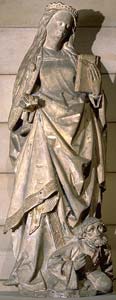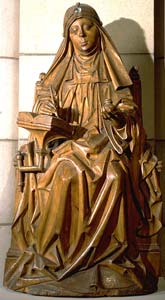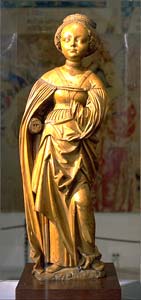 |
 |
 |
| Lecture 20. The Cult of Saints |
|
At least by the third century, we find the recognition of the intrinsic holiness of places on earth -- the tombs of the saints -- as the places where earth and heaven met. This is made very clear in the inscription on the tomb of Saint Martin of Tours: "Here lies the soul of Martin the bishop, of holy memory, whose soul is in the hand of God; but he is fully here, present and made plain in miracles of every kind." The two most important characteristics are thought of as physical presence and continuing power. The physical setting is characterized by light-reflective materials (marble and mosaic) and great golden candelabras would convey something of the Milky Way. We should not underestimate the revolution involved here--especially involving the abhorrence of the dead body in Late Antiquity. Note the comment by Julian the Apostate: "You keep adding many corpses newly dead to the corpses of long ago. You have filled the whole world with tombs and sepulchers." Physically the tomb and the altar became linked -- the bishop would perform public worship in close proximity to the dead. The body or relics of a martyr could be taken by a noble person (like Lupa at Santiago) and buried on a private estate where members of the family would then be associated in death. Alternatively, a bishop might take the initiative and transfer relics to a basilica that would be a focus for the cult. Bishops of the fifth century controlled enormous wealth. The open spaces of cemeteries allowed new and large-scale construction. The population of the city would be forced to leave in the form of a kind of pilgrimage linking all classes and both genders. We touched earlier on the cosmic linkage of heaven and earth in the cult of the saints and the tomb as a threshold. On a personal level, the saints were people that one could turn to for friendship, inspiration and protection, "invisible companions" (Brown) who could be invested with the precise and palpable features of beloved and powerful figures within contemporary society like the relationship between Paulinus of Nola and Saint Felix, "Now let me turn my poet's tongue in thanks to you, Felix, revered father, everlasting patron, Felix, my nurse, Felix, dear friend of Christ." The saint has grown closer to Christ after the grave; this close link can spill over to the person who fosters the special relationship. The custom developed of naming after a favorite saint--in a sense the named person is reborn and becomes the saint, recreating his life. Of course, such a close link and identification becomes most important in death when the patron can protect and intercede. The best way to gain such a benefit was to be buried close to the tomb of the patron. The tombs of the very special dead were exempt from the facts of death--the deep peace of their sleep before the resurrection shows in their bones. Relationship between the living and the dead is one of desire. Saint Augustine (Sermons): "I know you want to keep on living. You do not want to die. And you want to pass from this life to another in such a way that you will not rise again as a dead man but fully alive and transformed. This is what you desire. This is the deepest human feeling; mysteriously, the soul itself wishes and instinctively desires it." Close continuing relationship with the saint demands that you have information about his life and death. Hence the importance of the written account of the life and death of the saint or the passio that brings the saint into the present. And thus the repeated line, "hic locus est"--this is the place." This leads to the concern with Pilgrimage. Pilgrims travel to holy sites, but relics also travel in the form of a translation. There developed a ritual of adventus--the carrying of relics in procession with a ceremonial arrival. A means of unifying an entire population. And a means of organizing time. Consider how this is reflected in the development of the Christian calendar. Click on the name of the saint for a biographical note: |




